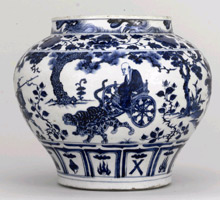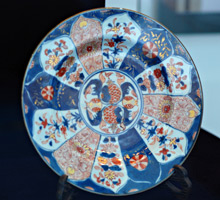|
 |
 |
|
A blue and white porcelain jar of the Yuan Dynasty (1206-1368) (XINHUA) |
An export-oriented porcelain product of Qing Dynasty (1644-1911) (CFP) |
The two types of products featured distinct regional flavor, attained a high degree of technical perfection, and represented the country's highest level of porcelain making at that time. Both the north and the south witnessed an ever-growing trend toward thinner roughcast, smoother glaze, and more exquisite and ingenious shapes.
Porcelain production continued to boom in the Liao, Song, Western Xia and Jin dynasties, a period from 916 to 1234. Well-known kilns spread all over the country, leading to the forming of eight major kiln styles—the Ding (Hebei Province), Jun (Henan Province), Yaozhou (Shaanxi Province) and Cizhou (Hebei Province) kilns in the north, and the Jingdezhen (Jiangxi Province), Longquan (Zhejiang Province), Jian (Fujian Province) and Yue (Zhejiang Province) kilns in the south.
Further, five celebrated kilns during the Song Dynasty (960-1279), which were Guan (imperial kiln), Ge, Ru, Ding and Jun kilns, became well-known for the production of fine porcelain, leading to a peak of China's porcelain production.
In the Yuan Dynasty (1206-1368), the country's porcelain-making techniques reached a higher level. In 1278, an imperial kiln was set up in Jingdezhen, Jiangxi Province. From then on Jingdezhen gradually developed into a porcelain production center for the country. With the invention of blue and white porcelain and underglaze red porcelain of kilns there, a new chapter of China's porcelain history started.
Blue and white porcelain was made by heating clay roughcast painted with blue pigment, generally cobalt oxide, under the glaze to a temperature of 1,300 degrees centigrade or so. Featuring strong Chinese national styles, this type of porcelain has been the dominant product for hundreds of years. Once invented, this blue and white porcelain was favored overseas and sold well. It remained in great demand for a long time, and became the embodiment of Chinese porcelain. (See P.41)
The country's porcelain making had its heyday during the Ming (1368-1644) and Qing (1636-1911) dynasties. Enjoying fame as "Porcelain Capital" for over 500 years, Jingdezhen produced a great variety of porcelain items in different colors and shapes, including numerous priceless porcelain works. The products of Jingdezhen not only served for the imperial families, but also enjoyed good sales both in and out of the country.
But, in the late period of the Qing Dynasty, China was hit by domestic social instability and foreign invasion. Given the unstable social environment, the country's ceramic industry waned rapidly.
Exporting
As early as the Western Han Dynasty (206 B.C.-A.D. 25), Zhang Qian, an envoy of the court of Han, was sent on diplomatic missions to kingdoms in the Western region (referring to areas west of Yumen Pass, including China's Xinjiang Uygur Autonomous Region and parts of Central Asia), thus opening up the overland Silk Road, the famous trade route connecting the East and the West.
The exporting of Chinese porcelain started in the end of the eighth century. With the prosperity of the maritime Silk Road during the Tang and Song dynasties (618-1279), Chinese porcelain, such as white porcelain of the Xing Kiln, celadon ware of the Yue Kiln and the colorful painted porcelain of kilns in Changsha, Hunan Province, began to be sold abroad in large quantities.
Painted porcelain vessels produced by the kilns in Changsha have been unearthed from 73 sites in 13 countries in Asia and Africa. These findings were mostly decorated in exotic styles such as Arabic words.
|
